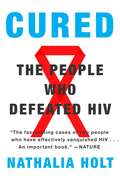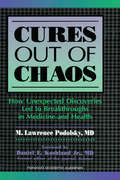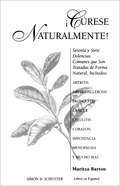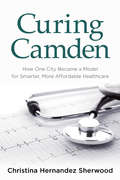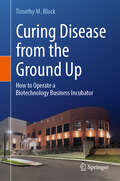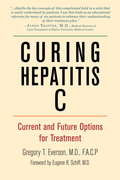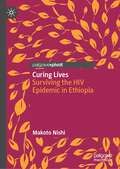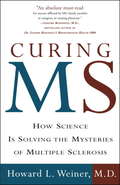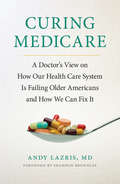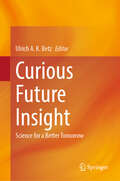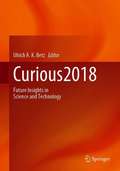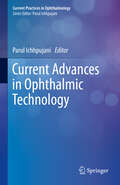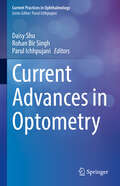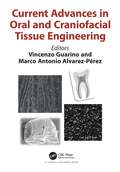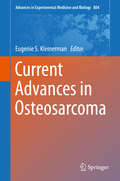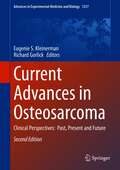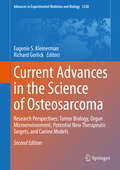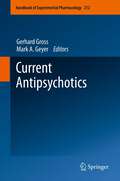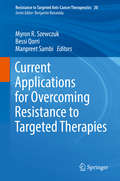- Table View
- List View
Cured
by Nathalia HoltIs the end of HIV upon us? Award-winning research scientist and HIV fellow at the Ragon Institute, Nathalia Holt, reveals the science behind the discovery of a functional cure and what it means for the millions affected by HIV and the history of the AIDS pandemic. Two men, known in medical journals as the Berlin Patients, revealed answers to a functional cure for HIV. Their cures came twelve years apart, the first in 1996 and the second in 2008. Each received his own very different treatment in Berlin, Germany, and each result spurred a new field of investigation, fueling innovative lines of research and sparking hope for the thirty-four million people currently infected with HIV. For the first time, Nathalia Holt, who has participated in some of the most fruitful research in the field, tells the story of how we came to arrive at this astounding and controversial turning point. Holt explores the two men’s stories on a personal level, looking at how their experiences have influenced HIV researchers worldwide#151;including one very special young family doctor who took the time to look closely at his patients#151;and how they responded to their medications. Based on extensive interviews with the patients and their doctors as well as her own in-depth research, this book is an unprecedented look at how scientists pursue their inquiries, the human impact their research has, and what is and is not working in the relationship between Big Pharma and medical care.
Cured by Nature: How to Heal from the Inside Out, Find Happiness, and Discover Your True Self
by Tara MackeyLife can be stressful, overwhelming, and sometimes difficult to cope with. Modern medical professionals will tell you to take various prescription medications, which can ultimately do more harm than good. But it doesn’t have to be that way! Healing is all in the mind and can be attained through finding harmony in your own life and resorting to natural remedies already provided by the very environment in which you live. Blogger Tara Mackey, who has a background in science, shares her own experiences with stress, depression, and anxiety and teaches you how to break free from them. Growing up, Tara suffered from dependency on various prescription drugs for depression, anxiety, and ADHD. She witnessed her best friend’s decline and suicide and watched helplessly as the effects of heroin addiction took a hold of her mother. At age twenty-four, she decided that enough was enough and quit her prescription meds cold-turkey in search for happiness. Today, she is drug-free, stress-free, and happy. Cured by Nature is Tara’s personal story combined with her knowledge and advice to battling personal demons and coming out victorious. Follow Tara as she shows you how to adapt and grow, using various herbal remedies, breathing exercises, and mind-strengthening techniques that will help you be a happier and better you.
Cures out of Chaos
by Daniel K. PodolskyThis volume describes important medical discoveries, from the introduction of the first antibiotic to the present, where serendipity, intuition, coincidence, or laboratory accident played an important role in bringing a discovery to light. Although chance is the principal determinant, the book emphasizes other factors, such as economic and politica
Curese Naturaltmente
by Maritza BartonA Spanish edition of the comprehensive guide to holistic cures provides an A-Z format that makes it easy for readers to research everything from arteriosclerosis and cancer to menopause and arthritis.
Curing Camden
by Christina Hernandez SherwoodAs the federal health reform debate played out in the national media spotlight, author Christina Hernandez Sherwood was reporting on the American medical system from the street level. From 2010 to 2012, she wrote a half-dozen stories for the Philadelphia Inquirer that focused on an innovative healthcare nonprofit: the Camden Coalition of Healthcare Providers. These stories centered on the nonprofit's role in combating falls, violence, diabetes, and other issues in Camden, New Jersey, a city known nationally as one of the country's poorest and most violent, but that is now making a name for itself as an innovation leader in the public health sector.In Curing Camden, all of Sherwood's articles have been collected into a single book, including the unpublished final installment profiling the nonprofit's founder. This book takes readers from the living rooms of Camden residents to the halls of the New Jersey State House in Trenton and beyond. Sherwood highlights how Camden could be the first US city to bend the cost curve by lowering healthcare costs while improving care. The ideas revealed in this book could be translated into practice across the country, and Camden could become a national model of 21st century medicine and public health.Much of the reporting Sherwood conducted was funded by prestigious journalism grants, from stories on diabetes and violence, to a revelatory report on falls, the number-one cause of injury-related hospital visits in Camden and in many hospitals across the country. Whether readers are curious about the intricacies and implications of President Barack Obama's signature Affordable Care Act law, or simply attempting to understand the jungle that is the US healthcare industry, Curing Camden reveals an inspiring case-study of lowered costs, improved care, and a potential systemic fix to what often seems to be our country's most intractable problems.
Curing Disease from the Ground Up: How to Operate a Biotechnology Business Incubator
by Timothy M. BlockThis operations manual offers an accessible, step-by-step guide to launching, running, and achieving success with a life science and biotechnology business incubator. Written by the founder and President Emeritus of the Pennsylvania Biotechnology Center (PABC), one of the most successful biotech and drug discovery incubators in the United States, it is designed to introduce researchers and funders to the broad considerations and minute details of managing an incubation program.As of 2023, there are more than 1100 business incubators in the United States alone, and more than 5000 worldwide. One of the fastest-growing industries of the "new economy," science business incubators are a tool for regional economic stimulation and commercial development for universities and research organizations. The PABC was founded in 2006 as a state-of-the-art research facility; its purpose and operation is unusual and its success has been remarkable. It was created by the nonprofit Hepatitis BFoundation and its research arm, the Baruch S. Blumberg Institute, to help their effort to find a cure for hepatitis B. But it has proved to be more than a source of funding for those nonprofits – it has become a major economic driver for its region and Pennsylvania, creating thousands of jobs and bringing in billions of dollars to the local economy. The PABC’s model has drawn attention from economists, legislators, and the research community. The strategy of bringing nonprofit research organizations and biotech startups under one roof was a founding principle, and has created powerful, lasting collaborations between scientific innovators, entrepreneurs and investors. The partnerships forged at the PABC have led to the discovery, testing, and FDA approval of new drugs for cancer and gastrointestinal diseases and medical devices, as well as multiple multimillion-dollar IPOs, and thousands of jobs. There are currently more than 50 startups housed in the Center's offices, ranging in focusfrom pharmaceuticals and diagnostics, to medical wearables and nanomedicine research.Curing Disease from the Ground Up: How to Operate a Biotechnology Business Incubator tells both a personal story about the ups and downs of leveraging a business incubator to fund and find a cure for a deadly disease, as well as providing a practical guide to running a business incubator. It is a first-hand, expert perspective for running a science business incubator, and explains how the success of the PABC can be learned and replicated. Whether it is developing a mission-focused framework, the practicalities of managing a scalable, business-savvy research nonprofit, identifying ideal tenant partners, or planning for the infrastructure needs of a large research facility, this manual is the first and last stop for entrepreneurial thinkers in this field.
Curing Hepatitis C
by Gregory T. Everson Gene SchiffHepatitis C Doesn't Have to Be a Lifelong IllnessCuring Hepatitis C provides the latest information to guide you through the diagnosis and treatment of hepatitis C. If you or a loved one has been diagnosed with hepatitis C, this book provides an indispensable and comprehensive overview of everything you need to know to take the right steps toward a cure.For the nearly 160 million people worldwide and 4 million Americans diagnosed with hepatitis C, there is now hope. Although hepatitis C was once considered incurable, medical and technological innovations have made a cure possible. A new frontier of treatment options has improved upon previous methods by curbing side-effects more effectively and working to eradicate hepatitis C entirely. Curing Hepatitis C also includes:* Easy-to-understand explanations of the nature of hepatitis C * The revealing truth of misconceptions about hepatitis C * Tips to prevent, diagnose, cope with, and ultimately cure this disease* An overview of types of tests and how to understand your results* Breakthrough treatments and medications for hepatitis C, such as triple therapy* The next generation of treatments including interferon-free regimens, QUAD therapy, host-acting antivirals, and more* Personal anecdotes from those affected by hepatitis C
Curing Lives: Surviving the HIV Epidemic in Ethiopia
by Makoto NishiThis is a book about life during the HIV epidemic in Ethiopia, and seeks to understand how and why the global effort to achieve universal HIV treatment has shifted away from its initial focus on the excessive human suffering precipitated by the epidemic. When antiretroviral drugs became available in Ethiopia, they emerged as powerful agents of change: not only did they cure individuals, they also helped people overcome their fear of – and break the silence around – AIDS, while healing the social ruptures caused by the epidemic. Nevertheless, as this book argues, the very same agents have silently “reversed” these changes over the course of the past decade. These reversals have dissolved connections, re-incurred invisible social fissures, and allowed a large majority of people to stay indifferent to the suffering of individuals whose lives remain vulnerable under the current treatment regime. This whole process is a product of neoliberal global health interventions that determine which lives are worthy or unworthy of investment. This book will interest scholars of biopolitics and public health, those who study the developing world, and those interested in how pandemic interventions alter the lives of many.
Curing MS: How Science Is Solving the Mysteries of Multiple Sclerosis
by Howard L. WeinerWhat causes multiple sclerosis? When will there be a cure? Dr. Howard Weiner has spent nearly three decades trying to find answers to the mysteries of multiple sclerosis, an utterly confounding and debilitating disease that afflicts almost half a million Americans. Curing MS is his moving, personal account of the long-term scientific quest to pinpoint the origins of the disease and to find a breakthrough treatment for its victims. Dr. Weiner has been at the cutting edge of MS research and drug development, and he describes in clear and illuminating detail the science behind the symptoms and how new drugs may hold the key to "taming the monster." From the "Twenty-one Points" of MS--a concise breakdown of the knowns and unknowns of the disease--to stories from the frontlines of laboratories and hospitals, Curing MS offers a message of hope about new treatments and makes a powerful argument that a cure can--and will--be found.
Curing Medicare: A Doctor’s View on How Our Health Care System Is Failing Older Americans and How We Can Fix It
by Andy Lazris Shannon BrownleeAndy Lazris, MD, is a practicing primary care physician who experiences the effects of Medicare policy on a daily basis. As a result, he believes that the way we care for our elderly has taken a wrong turn and that Medicare is complicit in creating the very problems it seeks to solve. Aging is not a disease to be cured; it is a life stage to be lived. Lazris argues that aggressive treatments cannot change that fact but only get in the way and decrease quality of life. Unfortunately, Medicare's payment structure and rules deprive the elderly of the chance to pursue less aggressive care, which often yields the most humane and effective results. Medicare encourages and will pay more readily for hospitalization than for palliative and home care. It encourages and pays for high-tech assaults on disease rather than for the primary care that can make a real difference in the lives of the elderly. Lazris offers straightforward solutions to ensure Medicare’s solvency through sensible cost-effective plans that do not restrict patient choice or negate the doctor-patient relationship. Using both data and personal stories, he shows how Medicare needs to change in structure and purpose as the population ages, the physician pool becomes more specialized, and new medical technology becomes available. Curing Medicare demonstrates which medical interventions (medicines, tests, procedures) work and which can be harmful in many common conditions in the elderly; the harms and benefits of hospitalization; the current culture of long-term care; and how Medicare often promotes care that is ineffective, expensive, and contrary to what many elderly patients and their families really want.
Curing The Crisis: Options For America's Health Care
by Michael D ReaganWith private health insurance costs averaging over $300 per month, per person-and with 36 million Americans lacking coverage of any sort-it is easy to understand why health care has captured the public imagination as the domestic policy issue of the 1990s. Americans spend well over $800 billion a year on health care, yet we are neglecting ba
Curing the Colonizers: Hydrotherapy, Climatology, Andfrench Colonial Spas
by Eric T. Jennings"Beware! Against the poison that is Africa, there is but one antidote: Vichy. " So ran a 1924 advertisement for one of France's main spas. Throughout the French empire, spas featuring water cures, often combined with "climatic" cures, thrived during the nineteenth century and the twentieth. Water cures and high-altitude resorts were widely believed to serve vital therapeutic and even prophylactic functions against tropical disease and the tropics themselves. The Ministry of the Colonies published bulletins accrediting a host of spas thought to be effective against tropical ailments ranging from malaria to yellow fever; specialized guidebooks dispensed advice on the best spas for "colonial ills. " Administrators were granted regular furloughs to "take the waters" back home in France. In the colonies, spas assuaged homesickness by creating oases of France abroad. Colonizers frequented spas to maintain their strength, preserve their French identity, and cultivate their difference from the colonized. Combining the histories of empire, leisure, tourism, culture, and medicine, Eric T. Jennings sheds new light on the workings of empire by examining the rationale and practice of French colonial hydrotherapy between 1830 and 1962. He traces colonial acclimatization theory and the development of a "science" of hydrotherapy appropriate to colonial spaces, and he chronicles and compares the histories of spas in several French colonies--Guadeloupe, Madagascar, Tunisia, and Runion--and in France itself. Throughout Curing the Colonizers, Jennings illuminates the relationship between indigenous and French colonial therapeutic knowledge as well as the ultimate failure of the spas to make colonialism physically or morally safe for the French.
Curiosities in Medicine: Alphabetically
by Sibylle Scholtz Myriam Becker Lee MacMorris Achim LangenbucherThis anthology is devoted to the curious side of Medical History. Carl Sagan said: ”You have to know the past to understand the present.” This collection of 80 short stories, written by experts in the field, inspires curiosity and provides a detailed look at the History of Medicine. It investigates many topics, including ancient Egyptian knowledge, the fundamental importance of toothache and how it birthed Anesthesia, and why and when women were allowed to run marathons. The authors report on the background of rubber gloves, the stethoscope and the intraocular lens. Historically important biographies are included, such as those of Arthur Conan Doyle, Napoleon Bonaparte and Claude Monet. The book is relevant for those interested in Medicine and its curious history.
Curious Future Insight: Science for a Better Tomorrow
by Ulrich A. K. BetzThis book follows up the debate on the future of science and technology at the Curious2022 – Future Insight Conference, the second event in this conference series initiated on the occasion of Merck’s 350th anniversary. In the chapters, some of the world’s top scientists, managers and entrepreneurs explore breakthrough technologies and how they can be applied to make a better world for humanity. The book begins with an introduction to the vision of the conference “United by science for a better tomorrow” and the impacts caused by the pandemic, highlighting the importance of gathering like-minded people to discuss and support the advancement of science and technology for the benefit of humanity. In the first part of the book, readers will also find a chapter written by the Executive Board of Merck KGaA discussing the importance of curiosity for innovation and an overview of the company’s contribution in the areas of life sciences, healthcare and electronics forward-moving the scientific discovery. The second part of the book offers insights of some of the scientific topics discussed at the conference, and particular attention is given to new therapies and sustainability. In the final part of the book, readers will find some thoughts on ethical principles guiding our application of science and technology to create a bright future for humanity, and diverse perspectives on topics such as health, life sciences, nutrition, material sciences, digitalization, AI, energy, mobility, space flight, robotics, the secrets of the human mind and new ways of working together. Given its interdisciplinary appeal, the book will inspire curiosity in a wide readership, from scholars and researchers to professionals with an interest in exploring the future of science and technology, solving the problems of today, and paving the way for a better tomorrow. Chapters 1 and 2 are available open access under a Creative Commons Attribution 4.0 International License via link.springer.com
Curious2018: Future Insights in Science and Technology
by Ulrich A. K. BetzThis book expands the debate on the future of science and technology at the Curious2018 – Future Insight Conference, held on the occasion of Merck’s 350-year anniversary. In the respective chapters, some of the world’s top scientists, managers and entrepreneurs explore breakthrough technologies and how they can be applied to make a better world for humanity.Divided into three parts, the book begins with an introduction to the vision of the conference and to the importance of curiosity for innovation, while also exploring the latest scientific developments that are shaping the future of healthcare, medicine, the life and material sciences, digitalization and new ways of working together. In the second part, particular attention is paid to new therapies and diagnostics; here, readers will learn how synthetic biology and chemistry are being used to solve problems that are essential to the future of humanity. The role of in-silico research is also discussed. In the final part of the book, readers will find some thoughts on ethical principles guiding our application of science and technology to create a bright future for humanity.Given its interdisciplinary appeal, the book will inspire curiosity in a wide readership, from scholars and researchers to professionals with an interest in exploring the future of science and technology, solving the problems of today, and paving the way for a better tomorrow.Chapters 1, 2, 3 and 17 are available open access under a Creative Commons Attribution-NonCommercial 4.0 International License via link.springer.com.
Current Advances in Ocular Surgery (Current Practices in Ophthalmology)
by Edmund Tsui Simon S. M. Fung Rohan Bir SinghThe book discusses innovations in surgical techniques and procedures in multiple ophthalmic subspecialties with an evidence based approach.With the rapid development of the field of ophthalmology over the last 10 years, from the development of ever more sophisticated ocular diagnostic technology, to the development of novel medical therapies, ophthalmologists have seen dramatic advancements in the care of their patients.The book highlights various ophthalmic surgical techniques that have been devised, modified, and refined over the last decade, allowing ophthalmic surgeons to achieve surgical perfection. It includes illustrations, clinical photos, videos of surgical procedure. It includes easy to follow salient points in each chapter.This volume of the Current Practices in Ophthalmology book series serves as a valuable resource for post graduate residents in ophthalmology, practicing ophthalmologists, subspecialty fellows, vision science researchers, and general ophthalmologists.
Current Advances in Ophthalmic Technology (Current Practices in Ophthalmology)
by Parul IchhpujaniThis book provides an overview of the latest technological advances in various ophthalmology subspecialties: from the latest glaucoma shunt devices to mobile adaptors for posterior segment evaluation, this book has it all. It gives readers a valuable head start for adopting the uber-new and cutting-edge products now available on the market. Being familiar with these new products and technologies will help both new and established ophthalmologists make effective and efficient choices, while also helping their practices stand out from the crowd. Perhaps no other branch of medicine is as technology-oriented as ophthalmology: be it lasers, fiber optics, robotics, stem cells or nanoparticles, every cutting-edge step that “Research and Development” takes is rapidly integrated into everyday eye practice.As part of the series “Current Practices in Ophthalmology”, this volume is intended for residents, fellows-in-training, generalist ophthalmologists, specialists and vision science researchers alike.
Current Advances in Optometry (Current Practices in Ophthalmology)
by Parul Ichhpujani Rohan Bir Singh Daisy ShuThis book provides insights into the rapid progression of optometry as an allied subspecialty of ophthalmology over the past two decades. It details how sophisticated diagnostic technologies and highly efficacious novel therapies have revolutionized the field. The chapters cover topics such as cutting-edge diagnostic tools, groundbreaking therapeutic approaches, and the integration of new technologies into clinical practice. Written by global experts, the book addresses the critical question of how these technologies have transformed patient care. Additionally, it discusses the latest trends in vision science research. This book is relevant for optometry and ophthalmology residents, practicing optometrists and ophthalmologists, vision science researchers, as well as general optometrists and ophthalmologists in training, providing insights into the latest developments in the field.
Current Advances in Oral and Craniofacial Tissue Engineering
by Vincenzo Guarino and Marco Antonio Alvarez-PérezOral tissue engineering involves the study of current approaches for in vitro regeneration of soft and hard tissues located into the oral cavity. In this context, recent approaches involves the use of innovative biomaterials to replace the lost or damaged human oral tissues. Recent discoveries in materials science and nanotechnology are drastically changing the traditional approach to dentistry by the design of innovative devices able more efficiently supporting the natural regeneration process. The objective of this book is to highlight current progress in tissue engineering for various dental hard/soft tissues including enamel, dentin, pulp, alveolar bone, periodontium, gum and oral mucosa, by emphasizing the role of materials and their specific applications.
Current Advances in Osteosarcoma (Advances in Experimental Medicine and Biology #Vol. 804)
by Eugenie S. KleinermanCurrent Advances in Osteosarcoma edited by Dr. Eugenie S. Kleinerman summarizes molecular and genetic characteristics, new therapeutic ideas, and biological characteristics that have been uncovered in the past 10 years. Osteosarcoma is an aggressive malignant neoplasm and it is also the most common histological form of bone cancer It accounts for approximately 56% of new bone tumors, making it the most primary malignant bone tumor in children and adolescents. The lungs are the most common site of metastases and once osteosarcoma spreads to the lungs, it is very difficult to treat. To improve the outcome of this disease, the biology of osteosarcoma needs to be better understood. There are numerous investigators around the world who have made seminal discoveries about the important molecular pathways and genetic alterations that contribute to the development and metastases of osteosarcoma. Other investigators have proposed novel therapeutic strategies including some based on the molecular and genetic phenotype of the disease. Current Advances in Osteosarcoma summarizes all of these new discoveries in one singular text, which will help move the field forward.
Current Advances in Osteosarcoma: Clinical Perspectives: Past, Present and Future (Advances in Experimental Medicine and Biology #1257)
by Eugenie S. Kleinerman Richard GorlickThis thoroughly revised second edition complied in 2 books is an up-to-date overview of the current clinical advances in sarcoma and osteosarcoma. The new edition features detailed, in-depth discussions of microRNAs in osteosarcoma, historical perspectives of chemotherapy in the treatment of the disease, tumor targeted IL12 therapy and HER2 targeted therapy, the role of enhancer elements in regulating the prometastatic transcriptional program and more. Further, these essential volumes also includes new insights on Wnt signaling in osteosarcoma, the role of genomics, genetically modified T-cell therapy, liquid biopsy, oncolytic viruses, immunophenotyping, receptor tyrosine kinases and epigenetic-focused approaches for treatment of osteosarcoma metastases, as well as thoughts on the current standard of treatment for patients suffering from these cancers. In the years since the previous edition, there have been numerous new developments in this rapidly changing field; this new edition is both timely and urgently needed. When taken together these companion volumes, Current Clinical (Book 1) and Scientific (Book 2) Advances in Osteosarcoma, are a timely and urgently needed guide for laboratory investigators and clinical oncologists focused in sarcoma.
Current Advances in the Science of Osteosarcoma: Research Perspectives: Tumor Biology, Organ Microenvironment, Potential New Therapeutic Targets, and Canine Models (Advances in Experimental Medicine and Biology #1258)
by Eugenie S. Kleinerman Richard GorlickThis thoroughly revised second edition is an up-to-date overview of the new advances in the knowledge of the basic science in sarcoma and osteosarcoma. It features detailed, in-depth discussions of microRNAs in osteosarcoma, historical perspectives of chemotherapy in the treatment of the disease, tumor targeted IL12 therapy and HER2 targeted therapy, the role of enhancer elements in regulating the prometastatic transcriptional program and more. Further, this essential volume also includes new insights on Wnt signaling in osteosarcoma, the role of genomics, genetically modified T-cell therapy, liquid biopsy, oncolytic viruses, immunophenotyping, receptor tyrosine kinases and epigenetic-focused approaches for treatment of osteosarcoma metastases, as well as thoughts on the current standard of treatment for patients suffering from these cancers. In the years since the previous edition, there have been numerous new developments in this rapidly changing field; this new edition is both timely and urgently needed. When taken together these companion volumes, Current Clinical (Book 1) and Scientific (Book 2) Advances in Osteosarcoma, are a timely and urgently needed guide for laboratory investigators and clinical oncologists.
Current Antipsychotics (Handbook of Experimental Pharmacology #212)
by Gerhard Gross Mark A. GeyerSix decades after the serendipitous discovery of chlorpromazine as an antipsychotic and four decades after the launch of clozapine, the first atypical or second generation antipsychotic, psychopharmacology has arrived at an important crossroad. It is clear that pharmacological research and pharmaceutical development must now focus on complementary or even alternative mechanisms of action to address unmet medical needs, i.e. poorly treated domains of schizophrenia, improved acceptance by patients, better adherence to medication, safety in psychoses in demented patients, and avoiding cardiac and metabolic adverse effects. The first completely novel mechanisms evolving from our insights into the pathophysiology of psychotic disorders, especially the role of glutamatergic mechanisms in schizophrenia, are now under development, and further principles are on the horizon. This situation, in many respects similar to that when the initial second-generation antipsychotics became available, can be rewarding for all. Preclinical and clinical researchers now have the opportunity to confirm their hypotheses and the pharmaceutical industry may be able to develop really novel classes of therapeutics. When we were approached by the publishers of the Handbook of Experimental Pharmacology to prepare a new volume on antipsychotics, our intention was to capture both, the accumulated preclinical and clinical knowledge about current antipsychotics as well as prospects for new and potentially more specific antischizophrenia principles. These efforts should be based on the pathophysiology of the diseases and the affected neurotransmitter systems. Since preclinical research on antipsychotic compounds is only reliable when intimately linked through translational aspects to clinical results, we decided to include clinical science as well. It turned out that that this endeavor could not be covered by a single volume. We thank the editorial board and the publishers for supporting our decision to prepare two volumes: Current Antipsychotics and Novel Antischizophrenia Treatments. These topics cannot really be separated from one another and should be seen as a composite entity despite the somewhat arbitrary separation of contributions into two volumes. The continuing challenges of developing improved and safer antipsychotic medications remain of concern and are discussed in the first volume. The new opportunities for the field to develop and license adjunctive treatments for the negative symptoms and cognitive deficits that are treated inadequately by existing compounds have been incentivized recently and provide the focus for the second volume. We hope these collective contributions will facilitate the development of improved treatments for the full range of symptomatology seen in the group of schizophrenias and other major psychotic disorders. Gerhard Gross, Ludwigshafen, Germany Mark A. Geyer, La Jolla, CA This volume will try to put current therapy - achievements, shortcomings, remaining medical needs - and emerging new targets into the context of increasing knowledge regarding the genetic and neurodevelopmental contributions to the pathophysiology of schizophrenia. Some of the chapters will also deal with respective experimental and clinical methodology, biomarkers, and translational aspects of drug development. Non-schizophrenia indications will be covered to some extent, but not exhaustively.
Current Applications for Overcoming Resistance to Targeted Therapies (Resistance to Targeted Anti-Cancer Therapeutics #20)
by Myron R. Szewczuk Bessi Qorri Manpreet SambiTargeted therapies were initially developed to exploit the upregulation and dependence on key oncogenic pathways critical to cancer progression. Additionally, they also presented as a method to overcome chemoresistance by supplementing conventional therapeutic regimens with targeted therapies. However, the development of resistance to these combinatorial approaches has led to the reassessment of currently available therapeutic options to overcome resistance to targeted therapy. This book aims to provide an update on the advancements in the therapeutic arms race between cancer, clinicians and scientists alike to overcome resistance to targeted therapies. Subject experts provide a comprehensive overview of the challenges and solutions to resistance to several conventional targeted therapies in addition to providing a discussion on broad topics including targeting components of the tumor microenvironment, emerging therapeutic options, and novel areas to be explored concerning nanotechnology and the epigenome.
